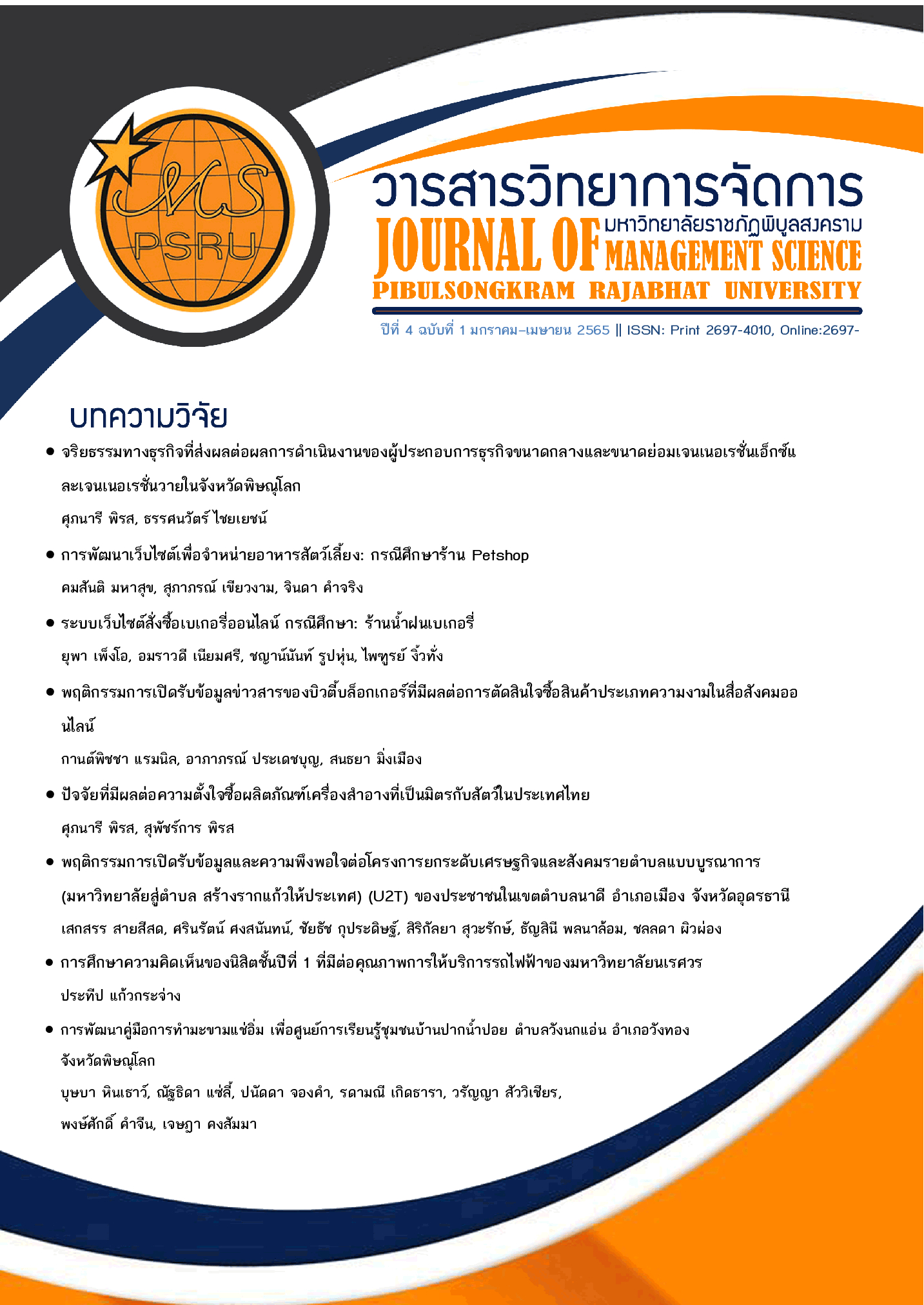ปัจจัยที่มีผลต่อความตั้งใจซื้อผลิตภัณฑ์เครื่องสำอางที่เป็นมิตรกับสัตว์ในประเทศไทย
คำสำคัญ:
ความตั้งใจซื้อ , ผลิตภัณฑ์เครื่องสำอางที่เป็นมิตรกับสัตว์ , ผลิตภัณฑ์เครื่องสำอางในประเทศไทยบทคัดย่อ
การวิจัยนี้มีวัตถุประสงค์ คือ เพื่อศึกษาอิทธิพลของปัจจัยที่มีผลต่อความตั้งใจซื้อผลิตภัณฑ์เครื่องสำอางที่เป็นมิตรกับสัตว์ในประเทศไทย ซึ่งงานวิจัยนี้ใช้กลุ่มตัวอย่าง คือ ผู้บริโภคที่ซื้อผลิตภัณฑ์เครื่องสำอางที่เป็นมิตรกับสัตว์ในประเทศไทย จำนวนทั้งสิ้น 215 คน โดยทำการสุ่มแบบสะดวก เครื่องมือที่ใช้ในการวิจัยเป็นแบบสอบถามเป็นมาตราส่วนประมาณ 5 ค่าระดับของลิเคิร์ท ซึ่งจัดส่งในช่องทางออนไลน์ สถิติที่ใช้ในการวิเคราะห์ข้อมูล ได้แก่ ความถี่ ค่าร้อยละ ค่าเฉลี่ย ค่าส่วนเบี่ยงเบนมาตรฐาน และการวิเคราะห์ถดถอยเชิงพหุคูณ
ผลการศึกษา พบว่า ทัศนคติ (= 0.252, p < 0.01) ความรู้ในปัญหาการทดลองในสัตว์(= 0.249, p < 0.01) ความไว้วางใจ (= 0.185, p < 0.10) และการวางจำหน่าย(= 0.127,p < 0.10) มีอิทธิพลในเชิงบวกต่อความตั้งใจซื้อของผู้บริโภคผลิตภัณฑ์เครื่องสำอางที่เป็นมิตรกับสัตว์ในประเทศไทย ดังนั้น ผู้ประกอบการอุตสาหกรรมเครื่องสำอางควรให้ความสำคัญในเรื่องของการสร้างทัศนคติที่ดีต่อผู้บริโภค ให้ข้อมูลความรู้เกี่ยวกับปัญหาของการทดลองในสัตว์ สร้างความไว้วางใจต่อผู้บริโภคและจัดการช่องทางการจำหน่ายให้เข้าถึงผู้บริโภคโดยทั่วถึง
เอกสารอ้างอิง
กระทรวงสาธารณสุข. (2564). ยุทธศาสตร์การพัฒนาประเทศไทยให้เป็นศูนย์กลางสุขภาพนานาชาติ พ.ศ.2560 – 2569. สืบค้น 20 ตุลาคม 2564, จาก https://hss.moph.go.th/fileupload/2560-102.pdf.
ฐานเศรษฐกิจ. (2564). เครื่องสำอางไทยฮอต คนรักสวยรักงามแห่ช้อป. สืบค้น 25 ธันวาคม 2564, จาก https://www.thansettakij.com/business/476559.
สมาคมผู้ผลิตเครื่องสำอางไทย. (2564). เครื่องสำอางไทยสุดฮอต ดันไทยขึ้นแท่นส่งออกอันดับ 2 อาเซียน อันดับ 10 ของโลก แนะใช้ FTA เพิ่มโอกาสขยายตลาด. สืบค้น 24 พฤศจิกายน 2564, จาก http://thaicosmetic.org/index.php/tcmanews/news-from-media/78-2021-05-24-04-38-48.
Aaker, D.A., Kumar, V. & Day, G.S. (2001). Marketing Research (7 th). New York: Wiley.
Aziz, N.N.A., Wahab, E., Aziz, N.A.A. & Hassan, W.H. (2017). The Impact of Attitude, Subjective Norm and Safety on Consumers’ Purchase Intention in Johor, Malaysia. Malaysian E-Commerce Journal, 1(2), 17-19.
Azmawani, A., Ebrahim, A. & Suhaimi, A. (2015). Consumer and Halal Cosmetic Products: Knowledge, Religiousity, Attitude, and Intention. Journal of Islamic Marketing, 6(1), 148-163.
Burton, S., Howlett, E., & Tangari, A. H. (2009). Food for thought: How Will the Nutrition Labeling of Quick Service Restaurant Menu Items Influence Consumers’ Product Evaluations, Purchase Intentions, and Choices?. Journal of Retailing, 85(3), 258–273.
Chen, K., & Deng, T. (2016). Research on the Green Purchase Intentions from the Perspective of Product Knowledge. Sustainability, 8(9), 943, 1-16.
Christine, K.Y.T., Kempa, S. & Vincecica-Gaile, Z. (2020). Determinant Factors in Purchasing Korean Skin Care Products. SHS Web of Conferences, 76, 1-12. DOI: https://doi.org/10.1051/shsconf/20207601021
Cochran, W.G. (1953). Sampling Techniques. New York: John Wiley & Sons. Inc.
Ferdinand, M. & Selamat, F. (2019). Brand Personality to Predict Brand Trust, Brand Attachment and Purchase Intention: Study on Cosmetic Products. In Jakata. Advances in Social Science, Education and Humanities Research, 439, 125-130. DOI: https://doi.org/10.2991/assehr.k.200515.022
Ghazali, E., Soon, P. C., Mutum, D. S., & Nguyen, B. (2017). Health and Cosmetics: Investigating Consumers’ Values for Buying Organic Personal Care Products. Journal of Retailing and Consumer Services, 39(6), 154-163. DOI: https://doi.org/10.1016/j.jretconser.2017 .08.002.
Gibson, C. (2000). Learners and Learning: The Need for Theory. In W. G. Anderson (Ed.), A Handbook of Distance Learning. The Pennsylvania State University Press.
Gilitwala, B. & Nag, A.K. (2021). Factors Influencing Youngsters’ Consumption Behavior on High- End Cosmetics in China. Journal of Asian Finance, Economics, and Business, 8(1), 443-450.
Hair, Jr., J.F., Black, W.C., Babin, B.J. & Anderson, R.E. (2010). Multivariate Data Analysis: A global perspective 7th ed. New Jersey: Pearson.
Handriana, T., Yulianti, P., Kurniawati, M., Arina, N. A., Aisyah, R. A., Ayu Aryani, M. G., & Wandira, R. K. (2020). Purchase Behavior of Millennial Female Generation on Halal Cosmetic Products. Journal of Islamic Marketing, 12(7), 1295-1315.
Kim, H.Y, & Chung, J.-E. (2011). Consumer Purchase Intention for Organic Personal Care Products. Journal of Consumer Marketing, 28(1), 40-47.
Kolyesnikova, N., Laverie, D. A., Duhan, D. F., Wilcox, J. B., & Dodd, T. H. (2010). The Influence of Product Knowledge on Purchase Venue Choice: Does Knowing More Lead from Bricks to Clicks? Supply Chain Forum: An International Journal, 11(1), 28-40.
Lee, H.S., Sun, P.C., Chen, T.S. & J.Y.J. (2015). The Effects of Avatar on Trust and Purchase Intention of Female Online Consumer: Consumer Knowledge as A Moderator. International Journal of Electronic Commerce Studies, 6(1), 99-118.
Lu, Y.C. & Chen, K.N. (2017). Consumer Knowledge, Brand Image, Openness to Experience and Involvement: A Case in Cosmetic Consumption. Journal of Cosmetics, Dermatological Sciences, and Applications, 7(4), 349-361. DOI: https://doi.org/10.4236/jcdsa.2017.74031
Mahliza, F. & Aditantri, R. (2022). Consumption Behavior of Halal Cosmetic Products: The Mediating Role of Trust on the Effect of Halal Certification on Purchase Intention. Journal of Economics, Finance and Management Studies, 5(1), 228-239.
Marketeer. (2565). ตลาดเครื่องสำอาง: ไทยส่งออกเป็นอันดับ 10 ของโลก. สืบค้น 9 มกราคม 2565, จาก https://shorturl.asia/7Yv6O
Nunnally, J.C., & Bernstein, I.H. (1994). Psychometric theory (3 rd ed.). New York: McGraw-Hill.
Phawanthaksa. (2562). ปี 62 โอกาสทองธุรกิจเครื่องสำอางและสกินแคร์. สืบค้น 30 ธันวาคม 2564, จาก https://www.smartsme.co.th/content/218721.
Rivis, A., & Sheeran, P. (2003). Descriptive Norms as an Additional Predictor in the Theory of Planned Behaviour: A Meta-analysis. Current Psychology, 22(3), 218–233. DOI: https://doi.org/10.1007/s12144-003-1018-2
Rovinelli, R. J., & Hambleton, R. K. (1976). On the Use of Content Specialists in the Assessment of Criterion-referenced Test Item Validity. Annual Meeting of the American Educational Research Association, 1-37.
Smith, S., & Paladino, A. (2010). Eating Clean and Green? Investigating Consumer Motivations towards the Purchase of Organic Food. Australasian Marketing Journal, 18(2), 93–104.
Steinhart, Y., & Mazursky, D. (2010). Purchase availability and involvement antecedents among financial products. International Journal of Bank Marketing, 28(2), 113–135.
Sulu, A.C., Saerang, D.P.E & Massie, J.D.D. (2016). The Analysis of Consumer Puchase Intention towards Cosmetic Products Based on Product Origin. Jurnal EMBA, 4(2), 332-342.
Thamaraiselvan, N., Arasu, B. S., and Inbaraj, J. D. (2017). Role of Celebrity in Cause-related Marketing. International Review on Public and Nonprofit Market. 14(3), 341–357. DOI: https://doi.org/10.1007/s12208-017-0176-0
Tseng, S. C., & Hung, S. W. (2013). A Framework Identifying the Gaps between Customers’ Expectations and their Perceptions in Green Products. Journal of Cleaner Production, 59(15), 174–184.
Ventre, I. & Kolbe, D. (2020). The Impact of Perceived Usefulness of Online Reviews, Trust and Perceived Risk on Online Purchase Intention in Emerging Markets: A Mexican Perspective. Journal of International Consumer Marketing, 32(4), 1-12.
Walter, A.B. & Didia,J.U.D. (2018). Consumer Knowledge and Purchase Intention of Healthcare Product Consumers in Rivers State. International Journal of Business & Law Research, 6(1), 1-7.
Yeow, P., Dean, A., & Tucker, D. (2014). Bags for Life: The Embedding of Ethical Consumerism. Journal of Business Ethics, 125(1), 87-99.
Yunus, N.M., Som, R.M., Majid, A.A., Abdul, U.M. & Abas, M.K. (2018). Generation Y Purchase Intention of Personal Care Products: The Influence of Attitude, Subjective Norms and Perceived Behavioural Control. Journal of International Business, Economics, and Entrepreneurship, 3(2), 30-36.
ดาวน์โหลด
เผยแพร่แล้ว
รูปแบบการอ้างอิง
ฉบับ
ประเภทบทความ
สัญญาอนุญาต
ลิขสิทธิ์ (c) 2022 มหาวิทยาลัยราชภัฎพิบูลสงคราม

อนุญาตภายใต้เงื่อนไข Creative Commons Attribution-NonCommercial-NoDerivatives 4.0 International License.
บทความที่ได้รับการตีพิมพ์ในวารสารวิทยาการจัดการมหาวิทยาลัยราชภัฏพิบูลสงคราม เป็นลิขสิทธิ์ของ คณะวิทยาการจัดการ มหาวิทยาลัยราชภัฎพิบูลสงคราม บทความที่ลงพิมพ์ใน วารสารวิทยาการจัดการมหาวิทยาลัยราชภัฎพิบูลสงคราม ถือว่าเป็นความเห็นส่วนตัวของผู้เขียน คณะบรรณาธิการไม่จำเป็นต้องเห็นด้วย ผู้เขียนต้องรับผิดชอบต่อบทความของตนเอง



